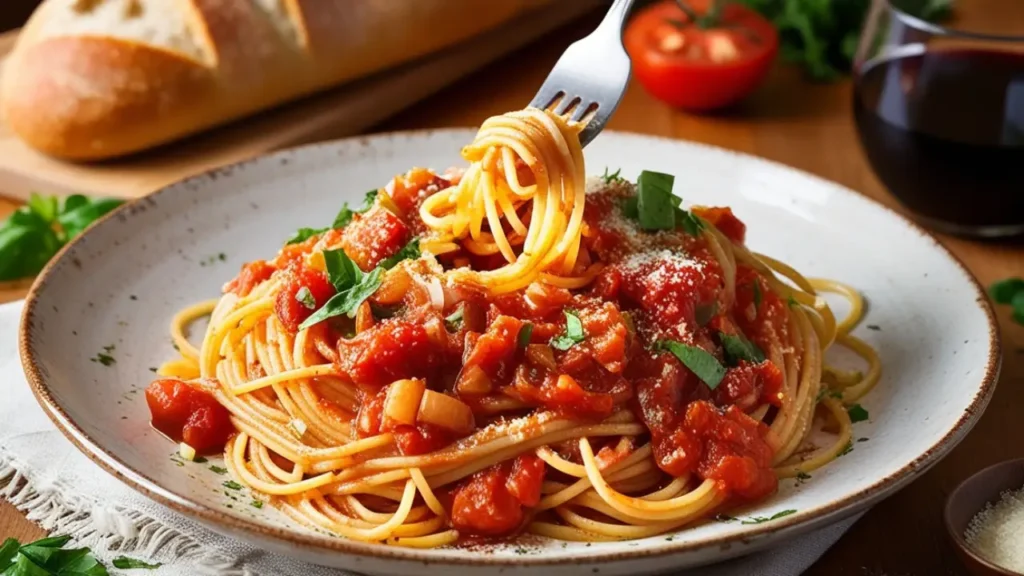Spaghetti with Marinara Sauce
There’s something universally comforting about a plate of spaghetti draped in vibrant marinara sauce, crowned with a snowfall of Parmesan cheese. This dish, rooted in Italian-American tradition, marries simplicity with bold flavors, making it a weeknight staple or a crowd-pleasing dinner for any occasion. Whether you’re a novice cook or a seasoned chef, mastering this recipe guarantees a meal that’s both satisfying and endlessly customizable. Below, we’ll guide you through crafting the perfect spaghetti with marinara sauce, from selecting ingredients to plating like a pro.
The Origins of Marinara: A Sauce Steeped in History
Marinara sauce traces its roots to Naples, Italy, where sailors (marinai) concocted it as a quick, shelf-stable meal during long voyages. Unlike meat-heavy ragùs, marinara relies on tomatoes, garlic, herbs, and olive oil—ingredients that could withstand months at sea. Over time, Italian immigrants brought the recipe to America, where it evolved into the beloved staple we know today. Its tangy, garlicky profile pairs perfectly with al dente spaghetti, creating a dish that’s humble yet deeply flavorful.
Ingredients: What You’ll Need
For the Spaghetti:
- 1 lb (450g) dried spaghetti (or fresh, if preferred)
- 4 quarts water
- 2 tbsp kosher salt
For Homemade Marinara Sauce:
- 3 tbsp extra-virgin olive oil
- 4 garlic cloves, thinly sliced
- 1 (28-oz) can crushed San Marzano tomatoes
- 1 tsp dried oregano (or 1 tbsp fresh)
- 1 tsp red pepper flakes (optional, for heat)
- 1 small bunch fresh basil (stems reserved for sauce, leaves for garnish)
- Salt and black pepper, to taste
For Assembly:
- 1 cup freshly grated Parmesan cheese
- Fresh basil leaves, for garnish
- Extra olive oil, for drizzling
Shortcut Option:
- 3 cups store-bought marinara sauce (look for brands with minimal additives)
Step-by-Step Instructions
1. Cooking the Spaghetti: Perfect Al Dente Texture
Step 1: Bring 4 quarts of water to a rolling boil in a large pot. Add 2 tbsp of kosher salt—this seasons the pasta from the inside out.
Step 2: Add spaghetti, stirring immediately to prevent sticking. Cook according to package instructions, usually 8–10 minutes.
Step 3: Reserve ½ cup of pasta water before draining. This starchy liquid helps bind the sauce later.
Step 4: Drain spaghetti but do not rinse; rinsing removes the starch needed for sauce adhesion.
Pro Tip: Taste pasta 1–2 minutes before the timer ends. It should be tender yet firm to the bite (al dente).
2. Homemade Marinara Sauce: A 20-Minute Miracle
Step 1: Heat olive oil in a deep skillet over medium-low heat. Add garlic and sauté until fragrant (1–2 minutes). Avoid browning to prevent bitterness.
Step 2: Stir in crushed tomatoes, oregano, red pepper flakes (if using), and basil stems. Season with salt and pepper.
Step 3: Simmer uncovered for 15–20 minutes, stirring occasionally. The sauce should thicken slightly.
Step 4: Discard basil stems and adjust seasoning. For a smoother texture, blend with an immersion blender.
Flavor Boost: Add a splash of red wine or a pinch of sugar to balance acidity.
3. Elevating Store-Bought Sauce
Short on time? Jazz up jarred marinara:
- Sauté fresh garlic or onions in olive oil before adding the sauce.
- Stir in chopped basil, a pat of butter, or a Parmesan rind while heating.
- Simmer for 10 minutes to meld flavors.
4. Bringing It All Together
Step 1: Return drained spaghetti to the pot. Add marinara sauce and ¼ cup reserved pasta water. Toss over low heat for 1–2 minutes until the pasta is evenly coated. Add more pasta water if needed for a silky texture.
Step 2: Plate spaghetti, drizzle with olive oil, and top with Parmesan. Garnish with fresh basil.
Serving Suggestions & Variations
- Protein Add-Ins: Top with meatballs, sautéed shrimp, or grilled chicken.
- Vegetarian Twist: Fold in roasted veggies like zucchini, mushrooms, or spinach.
- Bread on the Side: Serve with garlic bread or a crisp green salad.
- Wine Pairing: Complement with a Chianti or Sangiovese.
Why Fresh Parmesan Matters
Pre-grated Parmesan often contains anti-caking agents that dull its flavor and texture. Freshly grated cheese melts luxuriously, offering nutty, umami-rich notes that elevate the dish. For a dairy-free version, try nutritional yeast or vegan Parmesan.
Storing Leftovers
Store pasta and sauce separately in airtight containers for up to 3 days. Reheat gently with a splash of water to revive the sauce’s consistency.
Conclusion: A Dish That Never Goes Out of Style
Spaghetti with marinara sauce is more than just a meal—it’s a canvas for creativity and a testament to the beauty of simplicity. Whether you opt for homemade sauce or a quality store-bought shortcut, this recipe promises a hearty, flavorful experience. So boil that water, uncork the wine, and savor the magic of a timeless classic.
Buon appetito! 🍝




Pingback: Smoky Lentil-Walnut “Meat” Stuffed Peppers